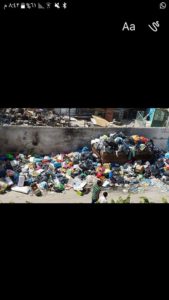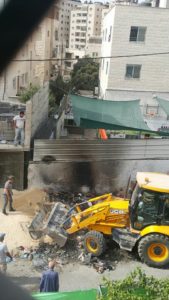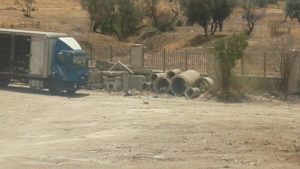They were smelly times, and they were actually quite dangerous times. Garbage overflowed in huge garbage receptacles and in empty lots throughout East Jerusalem, but they were rarely emptied. Garbage kept piling up, especially in Kufr Aqeb, and it became a public health hazard. Sometimes, residents burned the trash, just to get rid of it. But that, too, was a public safety and health hazard.
Until one day, after MiniActive’s almost 2-year ‘We Won’t Live in Filth!‘ campaign, municipal trucks came and emptied the receptacle. And many were happy – for a minute.
Until they saw what the garbage trucks had left behind…….A whole lot of garbage, probably enough to fill another truck. And then it became a public health AND safety hazard, as residents started to burn the garbage in an attempt to get rid of it.
We called the attention of this ugly sight to city council members and a deputy mayor through the 0202-A View from East Jerusalem Facebook page, and they promised to take care of it. Indeed, a few days later, it was cleared up. Here’s the tractor that was brought in:
Congratulations MiniActive! Good job 0202! Here’s the post from the 0202 English page summing up the incident:
And in a second achievement, another public health hazard was cleared away this past week in Wadi Joz, also the result of both MiniActive’s campaign. Our director, Dr. Hagai Agmon-Snir, told the back story in a Facebook post:
Some time 20 years ago, someone did work with large sewer pipes in Wadi Joz in East Jerusalem. It might have been the East Jerusalem Development Corporation, it might have been the Gichon (or what was before the Gichon, can’t remember exactly when the Gichon was formed). The contractor, who did the public works, just left broken or extra pipes, each of them 2 meters in diameter, in an empty field, and left, together with more building waste from work that had been done. There was no oversight on him.
An empty field with building waste is a great way to attract more building waste, or just plain waste, isn’t it kind of like a garbage can? And in this way, the situation in this field kept getting worse and worse, and the field became a serious safety and health hazard.
Three years ago, some residents had had enough and began to ask that the field be cleaned up. It’s private land, but there’s no doubt that most of the waste was left there from public works. At one point, our MiniActive volunteers in the area took it upon themselves to get the field cleaned up. They turned to the Gichon, who were very polite and explained that it wasn’t them, it was the East Jerusalem Development Corporation. The East Jerusalem Development Corporation said that they have no records from 20 years ago….After the MiniActive volunteers met with everyone, they sat down and wrote a letter to the Jerusalem Municipality, which said something to the effect of, “Look – we weren’t able to find out who’s directly responsible, but at the end of the day it’s Jerusalem – please take responsibility as the Municipality. Research, examine, demand – whatever you think fit – the main thing is that this hazard – which is also a serious safety hazard – is taken care of.”
The Municipality – from the regional cluster director to the Director General’s office – worked very hard to find solutions. And on July 12, there suddenly appeared heavy equipment that came to take the building waste away.
Hats off to MiniActive for another impressive achievement! Hats off to the Jerusalem Municipality for taking responsibility. Here’s a video of the newly-cleaned area:
Here’s Hagai’s Facebook post (in Hebrew):
And here’s the explanation of the event that was posted on 0202-A View from East Jerusalem:
Many thanks to the Jerusalem Foundation for their continued support of the MiniActive network.




